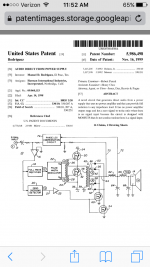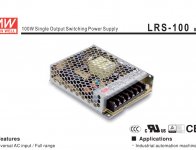I'm not going to bother reading the patent, but from the diagram it looks like a... class d amp. What am I missing?
so imagine you have purchased a switching power supply for your d amp.
it has a voltage trim pot.
if the ps output is modulated by audio rather than the pot then now only one assembly rather than two.
-
it has a voltage trim pot.
if the ps output is modulated by audio rather than the pot then now only one assembly rather than two.
-
So, then, I'm buying a finished class D amp with an internal AC/DC supply?
They exist. They probably have a switching PSU, rather than a simple unregulated rectified, filtered AC/DC supply.
Why should I care though, if I'm buying a single box. Price, perhaps? TPA3116 already has a PSRR of -70dB, which seems like it should be enough to run off a pretty basic rectified setup, and yet I think most products use an SMPS, and those that don't probably use a linear regulator.
Is there something more I am missing?
They exist. They probably have a switching PSU, rather than a simple unregulated rectified, filtered AC/DC supply.
Why should I care though, if I'm buying a single box. Price, perhaps? TPA3116 already has a PSRR of -70dB, which seems like it should be enough to run off a pretty basic rectified setup, and yet I think most products use an SMPS, and those that don't probably use a linear regulator.
Is there something more I am missing?
weight, size , ps impedance , peak power and now cost etc
im not sure they exist. possibly hypex or tripath but could be simply a matched ps-amp-module.
compare cost $$$$ and u see.
im thinking some student will thesis on the unity amp.
i cant put a 100w linear ps together for $8.
thats how much i pay for MW lrs100-24 .
the series linears are great for preamps but i use zeners.
im not sure they exist. possibly hypex or tripath but could be simply a matched ps-amp-module.
compare cost $$$$ and u see.
im thinking some student will thesis on the unity amp.
i cant put a 100w linear ps together for $8.
thats how much i pay for MW lrs100-24 .
the series linears are great for preamps but i use zeners.
The patent shows a power converter that can operate in the 1st and 3rd quarter of the output Voltage-Current plain, but not in the 2nd and 4th. So it is not suitable for driving a speaker with audio signal with acceptable quality.
Generally we can say that a good PSU+amp integrated solution contains as much parts as a separated PSU and amp. But contains more problems.
Generally we can say that a good PSU+amp integrated solution contains as much parts as a separated PSU and amp. But contains more problems.
nothing special on that patent, but i bet could do it with mixed signal fpga or pic32.
ok we wait and see if it comes or not.
ok we wait and see if it comes or not.
Yes, it can be done. But no benefit, because the same amount of (or more) parts are needed, and the quality is worse.
PIC32? Have you ever calculated jitter (noise) requirement?
PIC32? Have you ever calculated jitter (noise) requirement?
yes, if using pwm register must be in ext logic for a 2mhz reload cycle.
but many other techniques ie wireless systems use, ds spread-spectrum : it goes on and on ,you're not thinking.
basically need a fast host using ext logic or armcore fpga or both.
either way it is only written once then mass produced
its a undergrad level project , especially for our friends in Asia
-
but many other techniques ie wireless systems use, ds spread-spectrum : it goes on and on ,you're not thinking.
basically need a fast host using ext logic or armcore fpga or both.
either way it is only written once then mass produced
its a undergrad level project , especially for our friends in Asia
-
saturable core (mag amp) 'course' and modulation 'fine'?
i can go on listing but will leave it to others.
i can go on listing but will leave it to others.
you're not thinking.
basically need a fast host using ext logic or armcore fpga or both
You are very nice and thoughtful.
Please continue! Try to replace a comparator to a powerful FPGA, and a TL494 to a PIC32, do the high voltage level shifting at the ultrafast signals and expect it to be cheaper! Sounds very reasonable. The power topology still nowhere, but you know it will be awesome.
saturable core (mag amp) 'course' and modulation 'fine'?
i can go on listing...
Please don't! It's painful already. I can't read your mind.
weight, size , ps impedance , peak power and now cost etc
im not sure they exist. possibly hypex or tripath but could be simply a matched ps-amp-module.
compare cost $$$$ and u see.
im thinking some student will thesis on the unity amp.
i cant put a 100w linear ps together for $8.
thats how much i pay for MW lrs100-24 .
the series linears are great for preamps but i use zeners.
Ok, let's look at it another way. For less than $20 you can buy one 2x50 Class D board + a MW lrs100-24.
The price delta of an highly integrated unity amp product will be the sum of the savings from increased integration and elimination of redundant parts - amortized cost of R&D. I suspect that the # of unity amps you'll have to sell before the per-unit savings outweighs the R&D cost is going to be a rather large number.
Of course, it's not that simple. You might say the R&D cost for Meanwell to make an audio amp module would be quite small. You might be right, but then Meanwell has to figure out how to sell these things. They aren't in the amp business, they are in the PSU business. Their marketing team knows how to market PSUs. Their sales team knows how to sell lots and lots of PSUs. Because of that, and because the market for PSUs is larger than the market for amps, chances are good that their sales team will not figure out how to sell lots of amps.
I'm going to come back to my earlier question: What is the difference between this hypothetical Meanwell/Harmon Kardon product and using an existing Class D chip with decent PSRR with a rectified, filtered *unregulated* power supply? It seems like the main issue is that chips like the TPA3116 or TDA7492/8 couldn't cope with the absolute voltages, or the swings between the unloaded and loaded voltages. What about some of the others, the ones that use an external mosfet switch?
Last edited:
ok , this context is always voiced when anything out of classic paradigm is introduced.
I have been presenting to engineering audiences for 30+ years. Its normal and seen all of the time.
I'm not saying that Revision 0.01 prototype will be cost effective but each iteration does gets closer to the $$$$$ cross-over point $$$$$.
Mag amps just came to mind as possible part of overall solution but some people do actually build mag audio amps for fun.
Just for a mind experiment, think about a 400z sine inverter with strict harmonic (mil) spec, then extrapolate out to a amp in terms of a sub-woofer amp.
-bruce
I have been presenting to engineering audiences for 30+ years. Its normal and seen all of the time.
I'm not saying that Revision 0.01 prototype will be cost effective but each iteration does gets closer to the $$$$$ cross-over point $$$$$.
Mag amps just came to mind as possible part of overall solution but some people do actually build mag audio amps for fun.
Just for a mind experiment, think about a 400z sine inverter with strict harmonic (mil) spec, then extrapolate out to a amp in terms of a sub-woofer amp.
-bruce
David Berning's ZOTL tube amp does basically the same thing, but uses vacuum tubes for the linear "modulation" device. His patent predates this one by two years and he has been selling these things ever since.
Tube amplifiers for high-end audio by The David Berning Company
Tube amplifiers for high-end audio by The David Berning Company
Tube amplifiers for high-end audio by The David Berning Company
Tube amplifiers for high-end audio by The David Berning Company
David Berning's ZOTL tube amp does basically the same thing, but uses vacuum tubes for the linear "modulation" device. His patent predates this one by two years and he has been selling these things ever since.
Tube amplifiers for high-end audio by The David Berning Company
Tube amplifiers for high-end audio by The David Berning Company
This contains a push-pull amplifier and 2 SMPSs for replacing an audio transformer, and also needs 2 mains-isolated power supply. This is for 1 audio channel.
For comparison the current best solution contains 1 power chip, a single rail SMPS and a 12V low power supply, for stereo and a dedicated bass cannel (600 W max in sum), and the chip contains a DSP for some additional features. Compete with this!
ouch i just thought it could be reduced to one stage.
ok its just not worth exploring. but can i mount my amp inside the MW cage?
ok its just not worth exploring. but can i mount my amp inside the MW cage?
This contains a push-pull amplifier and 2 SMPSs
Yes, it is more complex than it needs to be. It was designed in 1997 by a guy who specializes in vacuum tube amps. The point made at the time was to replace an expensive iron vacuum tube output transformer with high speed switching magnetics, and combine the power supply and amplifier circuitry. In 1997 the mosfets and magnetics for a 100+ watt converter at say 1MHz were not common.
Today we can make a modulated converter that runs in the 1MHz + range with off the shelf parts. I designed such a converter several years ago for a mobile data radio where the modulation bandwidth was 100KHz, requiring a switching frequency of 1MHz. The requirements were different, it was a modulated buck / boost converter with a 12 volt input and a 9 to 32 volt output. I used two stages, boost 12 volts to 32 volts, feeding a modulated buck converter for 9 to 32.
It would be possible to make a modulated step down supply to operate from raw line, but isolation would still be required, and in some places in the world, PFC is needed, so we are still looking at two stages. Active PFC for worldwide line input to about 400 volts (typical), followed by a modulated buck converter. The technology exists today to do build this, is it being done commercially? I don't know, but there are an awful lot of cheap Chinese PA and MI amplifiers out there claiming kilowatt+ (Chinese) power ratings for a couple hundred bucks. I have not investigated how they are made.
- Status
- Not open for further replies.
- Home
- Amplifiers
- Class D
- MW Mean Well dual use

